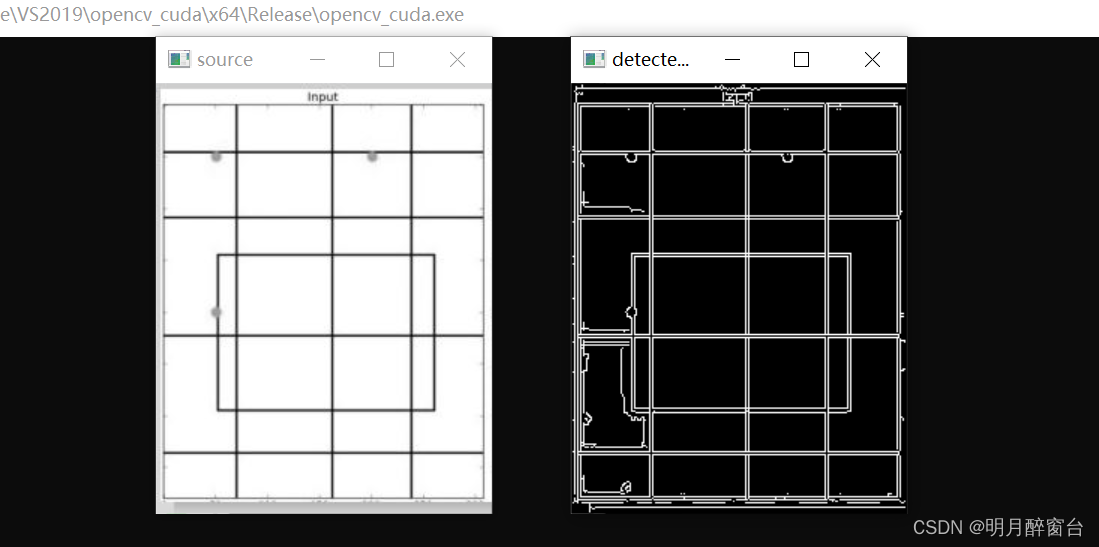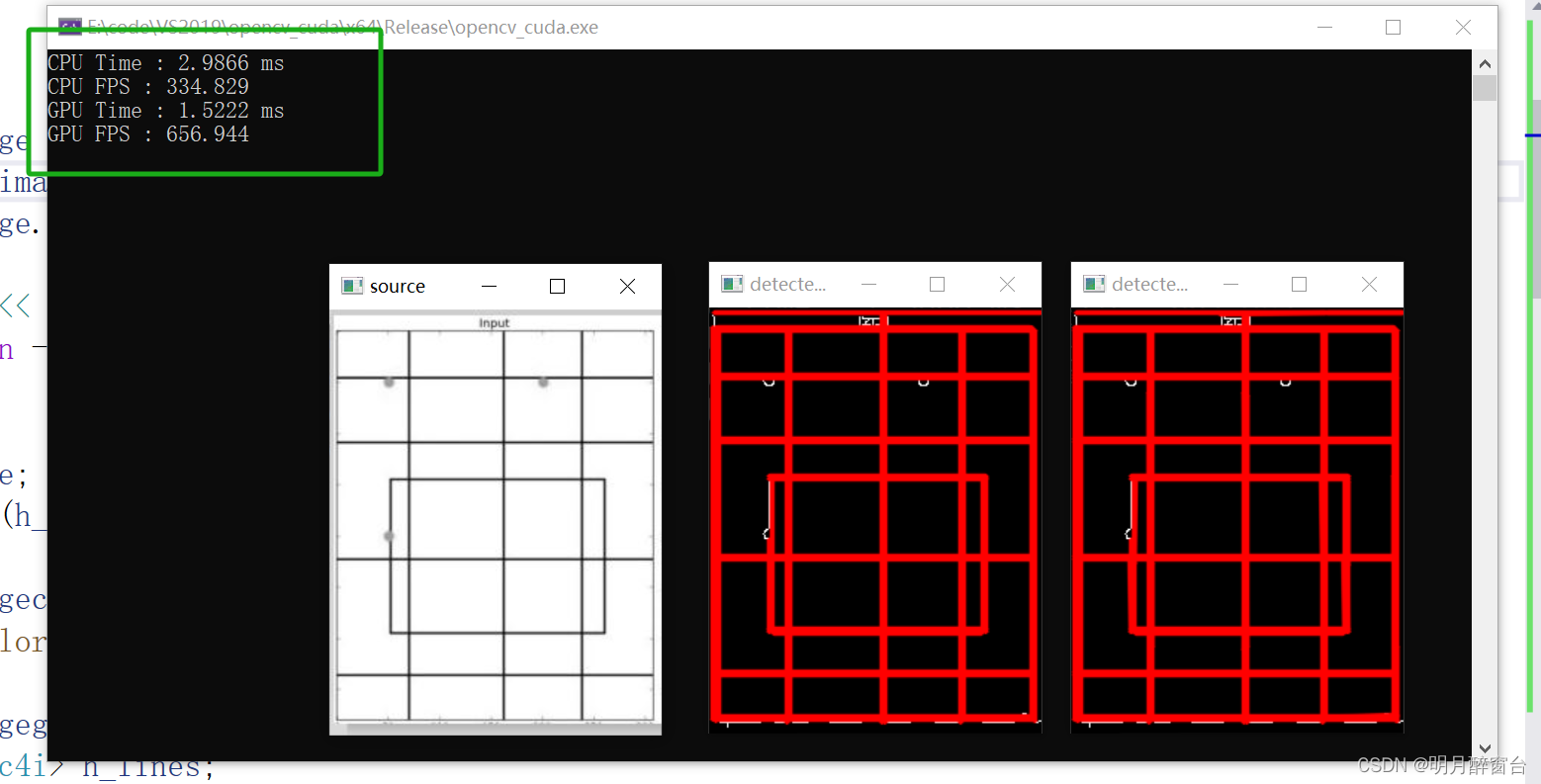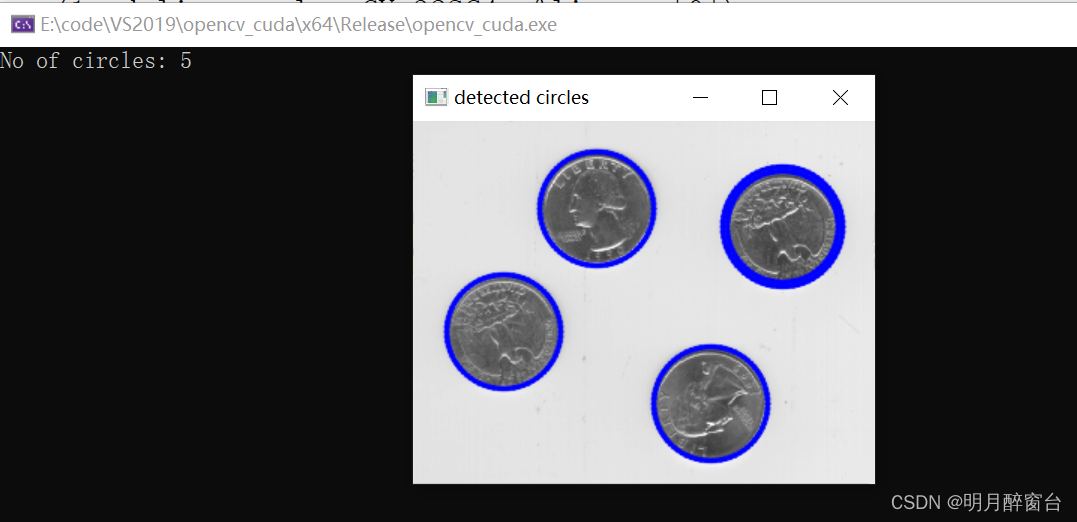Opencv_CUDA应用之 基于形状的对象检测与跟踪
- 形状可以用作全局特征检测具有不同形状的物体,可以是直线、多边形、圆形或者任何其他不规则形状
- 利用对象边界、边缘和轮廓可以检测具有特定形状的对象
- 本文将使用Canny边缘检测算法和Hough变换来检测两个规则形状,即线和圆
1. Canny 边缘检测
-
Canny 结合了高斯滤波、梯度寻找、非极大值抑制和滞后阈值处理
-
高通滤波器对噪声非常敏感,在Canny边缘检测中,检测边缘之前完成高斯平滑,在检测到边缘后从结果中移除不必要的边缘之后,还具有非极大值抑制阶段
-
算法代码如下:
#include <cmath>
#include <iostream>
#include "opencv2/opencv.hpp"
#include<opencv2/cudaimgproc.hpp>using namespace std;
using namespace cv;
using namespace cv::cuda;int main()
{Mat h_image = imread("images/drawing.JPG", 0);if (h_image.empty()){cout << "can not open image" << endl;return -1;}GpuMat d_edge, d_image;Mat h_edge;d_image.upload(h_image);cv::Ptr<cv::cuda::CannyEdgeDetector> canny_edge = cv::cuda::createCannyEdgeDetector(2.0, 100.0, 3, false);canny_edge->detect(d_image, d_edge);d_edge.download(h_edge);imshow("source", h_image);imshow("detected edges", h_edge);waitKey(0);return 0;
}

2. 使用 Hough 变换进行直线检测
- hough变换常用于直线检测、圆检测
- 直线检测函数解析:
/*
cv::cuda::createCannyEdgeDetector 函数参数:
第一个r表示在Hough变换中参数的分辨率,通常为1像素
第二个参数是theta在弧度中的分辨率,取1弧度或者pi/180
第三个参数是形成一条线所需点的最小数量
第四个参数是两点之间的最大间隙被视为同一条直线*/Ptr<cuda::HoughSegmentDetector> hough = cuda::createHoughSegmentDetector(1.0f, (float)(CV_PI / 180.0f), 50, 5);
- 实现代码如下:
#include <cmath>
#include <iostream>
#include "opencv2/opencv.hpp"
#include<opencv2/cudaimgproc.hpp>using namespace std;
using namespace cv;
using namespace cv::cuda;int main()
{Mat h_image = imread("images/drawing.JPG", 0);resize(h_image, h_image, h_image.size());if (h_image.empty()){cout << "can not open image" << endl;return -1;}Mat h_edge;cv::Canny(h_image, h_edge, 100, 200, 3);Mat h_imagec;cv::cvtColor(h_edge, h_imagec, COLOR_GRAY2BGR);Mat h_imageg = h_imagec.clone();vector<Vec4i> h_lines;{const int64 start = getTickCount();HoughLinesP(h_edge, h_lines, 1, CV_PI / 180, 50, 60, 5);const double time_elapsed = (getTickCount() - start) / getTickFrequency();cout << "CPU Time : " << time_elapsed * 1000 << " ms" << endl;cout << "CPU FPS : " << (1 / time_elapsed) << endl;}for (size_t i = 0; i < h_lines.size(); ++i){Vec4i line_point = h_lines[i];line(h_imagec, Point(line_point[0], line_point[1]), Point(line_point[2], line_point[3]), Scalar(0, 0, 255), 2, LINE_AA);}GpuMat d_edge, d_lines;d_edge.upload(h_edge);{const int64 start = getTickCount();Ptr<cuda::HoughSegmentDetector> hough = cuda::createHoughSegmentDetector(1.0f, (float)(CV_PI / 180.0f), 50, 5);hough->detect(d_edge, d_lines);const double time_elapsed = (getTickCount() - start) / getTickFrequency();cout << "GPU Time : " << time_elapsed * 1000 << " ms" << endl;cout << "GPU FPS : " << (1 / time_elapsed) << endl;}//取出直线两个点vector<Vec4i> lines_g;if (!d_lines.empty()){lines_g.resize(d_lines.cols);Mat h_lines(1, d_lines.cols, CV_32SC4, &lines_g[0]);d_lines.download(h_lines);}for (size_t i = 0; i < lines_g.size(); ++i){Vec4i line_point = lines_g[i];line(h_imageg, Point(line_point[0], line_point[1]), Point(line_point[2], line_point[3]), Scalar(0, 0, 255), 2, LINE_AA);}imshow("source", h_image);imshow("detected lines [CPU]", h_imagec);imshow("detected lines [GPU]", h_imageg);imwrite("hough_source.png", h_image);imwrite("hough_cpu_line.png", h_imagec);imwrite("hough_gpu_line.png", h_imageg);waitKey(0);return 0;
}

3. 对圆形进行检测
- 球检测或者硬币检测
- 圆检测函数解析:
/*
cv::cuda::createHoughCirclesDetector 参数
第一个参数是dp,表示累加器分辨率与图像分辨率的反比
第二个参数是检测到的圆中心之间的最小距离,调小会检测出其他错误圆,调大则可能丢失圆
第三个参数是Canny 阈值
第四个参数是累加器阈值
第五个和第六个参数是要检测的圆的最小和最大半径,不确定可以取0
*/
cv::Ptr<cv::cuda::HoughCirclesDetector> detector =
cv::cuda::createHoughCirclesDetector(1, 100, 122, 50, 1, max(h_image.size().width, h_image.size().height));
- 算法实现如下:
#include <iostream>
#include "opencv2/opencv.hpp"
#include<opencv2/cudaimgproc.hpp>using namespace cv;
using namespace std;int main(int argc, char** argv)
{Mat h_image = imread("images/eight.tif", IMREAD_COLOR);Mat h_gray;cvtColor(h_image, h_gray, COLOR_BGR2GRAY);cuda::GpuMat d_gray, d_result;std::vector<cv::Vec3f> d_Circles;medianBlur(h_gray, h_gray, 5);cv::Ptr<cv::cuda::HoughCirclesDetector> detector = cv::cuda::createHoughCirclesDetector(1, 100, 122, 50, 1, max(h_image.size().width, h_image.size().height));d_gray.upload(h_gray);detector->detect(d_gray, d_result);d_Circles.resize(d_result.size().width);if (!d_Circles.empty())d_result.row(0).download(cv::Mat(d_Circles).reshape(3, 1));cout << "No of circles: " << d_Circles.size() << endl;for (size_t i = 0; i < d_Circles.size(); i++){Vec3i cir = d_Circles[i];circle(h_image, Point(cir[0], cir[1]), cir[2], Scalar(255, 0, 0), 2, LINE_AA);}imshow("detected circles", h_image);waitKey(0);return 0;
}





通信接口)





详解)

,彻底掌握参数传递)


)
![[火灾警报系统]yolov5_7.0-pyside6火焰烟雾识别源码](http://pic.xiahunao.cn/[火灾警报系统]yolov5_7.0-pyside6火焰烟雾识别源码)


